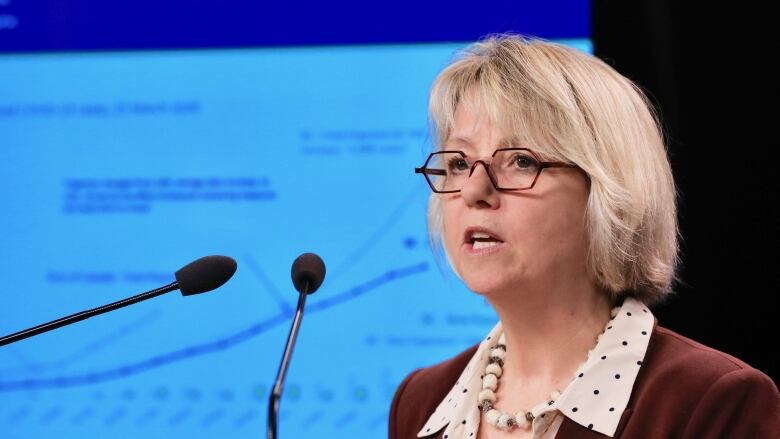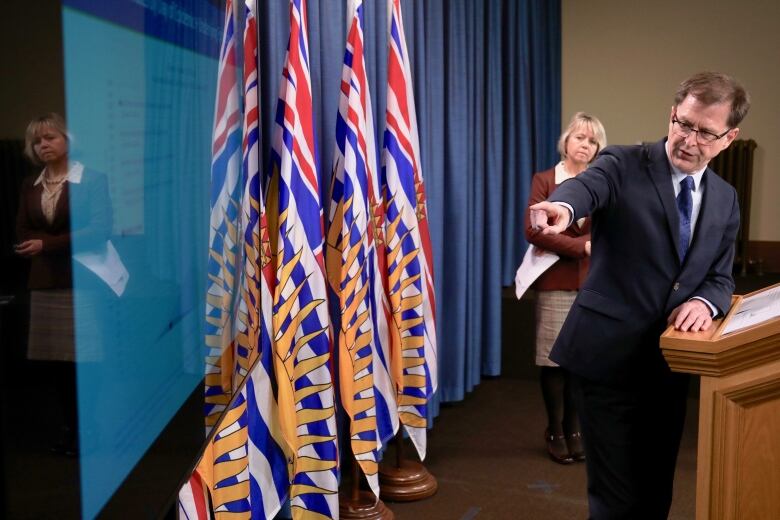Physical distancing has halved rate of spread of COVID-19 in B.C., official modelling suggests
B.C.'s 17 biggest hospitals have capacity to meet expected demand of severe outbreaks, officials say

Health officials say physical distancing restrictions in B.C.are successfully beginning to slowthe rate of spread of new COVID-19 casesin the province, perhaps by as much ashalf.
But despite the "glimmer of hope,"provincial health officer Dr. Bonnie Henryand otherofficials stressed thatthe province is not out of the woods and the health-care system still needs to be prepared for an inevitable surge in hospitalizations.
"I'm trying not to over-call it, but I do believe we've seen a flattening, a falling-off of that curve," Henry said Friday, referring to the growth of new COVID-19 patients in B.C.
"What we need, though, is for everybody to continue to pay attention to these [physical distancing] measures so we can continueto prevent transmissions in our communities ... for the coming weeks."
The hopeful news came as part of a report released Friday, which foundthat the province's health-care system is "reasonably" prepared to handle a surge in critical care cases related to COVID-19 if theflatter trajectory continues.
The report said 17 of thebiggest hospitals in B.C. have now been identified as primary COVID-19 treatment sites.
Officials say those hospitals are ready to meet demand,evenif the local outbreak were to mimic the severe scenarioseen in China's Hubei province.
If the situation in B.C. deterioratedto the point wherethe 17 hospitals could not keep up, as was the experiencein Italy, the province saidadditional centres are being prepared to care for the overflow.
Watch: Dr. Bonnie Henry outlines the modelling B.C. is using to make predictions around hospital capacity:
Compared to China, northern Italy
A number of health-care officialscompared the estimated trajectory of new cases in B.C. with the case growth previously seen intwo of the most severe coronavirus outbreaks: in northern Italy and China's Hubei province.
Both regions have been epicentres of the pandemic, with tens of thousands of cases and hospitalizations.
Taking those two regions' experiences as examples ofworst-case scenarios, B.C. looked at its own health-care systemto determine whether the province has enough beds and ventilators in case it goes down a similar path.
Henry said the data isfor planning purposes,cautioning that it isnot a prediction.
'Cascading'approach
B.C. said there is a likely scenario of the province's outbreak ending up below or at the samelevel seen in the Hubei province, where the pandemic originated in the city of Wuhan.
The report found the 17 provincialhospitals identified as primary carecentres would be prepared enough to handle that kindofoutbreak. They are the biggest hospitals across all of B.C.'s health authorities, with the highest level of expertise and capacity for critical care.

A briefing offered Friday, however, said that network would beoverwhelmed if B.C.'s outbreak reached a level likenorthern Italy's. ProvincialHealth Minister Adrian Dix said B.C. is developing a "cascading" approach to free up additional hospital bedsin case that happens, though it is not looking likely based on Friday'smodelling.
The province believes it should have enough ventilators to meet demand, even if it follows Italy's extreme pattern, assuming 80 per cent of patients in intensive care units (ICU) needto use them.
Dix said there are at least 1,272 ventilators in the province, with more on order.
The reportfound the most populatedareas of the province are better equipped for a bigger outbreak, with Northern Health seeing the lowest number of ventilators. It also said Interior Health and Island Health will have higher percentage of critical care hospitalizations because theirpopulations are generally older.
Restrictive measuresworking, province believes
The province believes restrictive measures around travel, large gatherings and physical distancing introduced between March 12 and 16 are saving B.C. from an outbreak scenario like China's or Italy's.
Without those measures, officials believe B.C. would be seeinga 24 per cent daily increase in cases or 215 new cases per million people, every day.
Instead, the report said, B.C. has only seen a 12 per cent daily increase since physical distancing began, or about 130 new cases per million people.
That growth rate islower than those of northernItaly and theHubei province.
Officials cautioned B.C. could still see a spike, if an outbreak happened in aremote community or a vulnerable care home.
Henry has also warned the 14-day incubation period is not over for people who were infected with the novel coronavirus before the restrictions began. She said it will be at least another week before we see the full effects of physical distancing.
B.C. has proactively freed up more than 3,900hospital beds by deferring non-essential surgeries, something that didn't happen in overwhelmed countries like Italy.
If you have a COVID-19-related story we should pursue that affects British Columbians, please email us at impact@cbc.ca.
With files from CBC's Justin McElroy and The Canadian Press













_(720p).jpg)


 OFFICIAL HD MUSIC VIDEO.jpg)
.jpg)



























































































